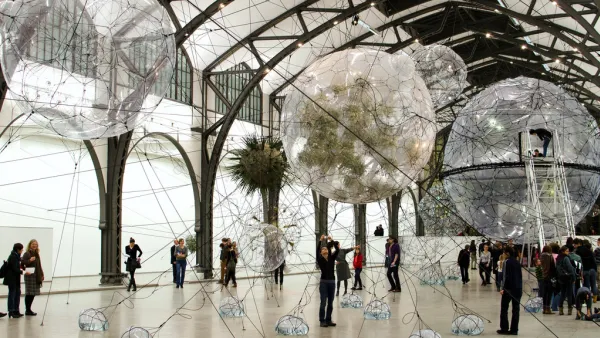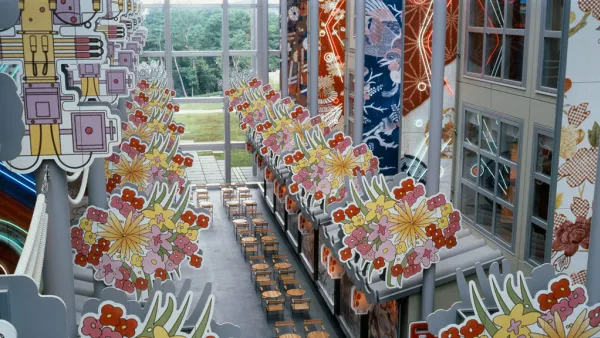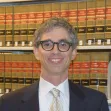World
Global issues, U.N., etc.
CO2 Levels Approach Troubling Milestone
The concentration of carbon dioxide in the Earth's atmosphere is fast approaching levels not seen for millions of years. At 400 parts per million (p.p.m.), the planet is fast approaching the point of no return for avoiding dangerous climate change.
How Facebook Simulates Suburbia: Lessons for Building Public Spaces in the Digital Age
As the virtual and physical worlds become more intertwined, the role of the traditional architect and the information architect become more closely aligned. Emily Badger explores the ways that each discipline can help the other design public spaces.
Craft and Context: Architecture that Connects Place and Time
Architect Mark Sofield explores the essential meaning of craft in architecture, which he says lies in the nature of the connections a building or space creates.
'Quantitative Urbanism' Reduces Cities to a Formula
Jerry Adler examines the emerging field of “quantitative urbanism,” which aims to use mathematical formulas to unveil and explain the universal properties shared by cities.

Ranking the World's Most Bike-Friendly Cities
The Copenhagen-based urban planning consultancy Copenhagenize Design Co. has released the follow-up to its 2011 rankings of the world's most bike-friendly cities. Only one city in North America cracked the top 20.
The Future of Municipal Planning 02: Learning from Success
Urban design studios and a plethora of new data demonstrate the value of successful placemaking. Howard Blackson sees these as key components of future municipal planning.
Successional Urbanism: An Interview with Andrés Duany
Architect and town planner Galina Tachieva sits down with New Urbanism innovator Andrés Duany to discuss the big and small topics on his mind today: lean urbanism, successional urbanism and the Transect, the orthodoxy of the small block, and more.
Friday Funny: 15 Mid-Century Modern Death Traps
With their flexible open spaces, right angles, and expanses of glass, mid-century modern houses are coveted by those homeowners with a keen design sense. And, as Projectophile illustrates, it's best if those homeowners don't have children.
Lighting Revolution Produces Radiant Visions of Our Future
The technological advances transforming "Edison’s 130-year-old industry" promise to revolutionize the way light is integrated in our homes, workplaces, and cities.
Driverless Cars Are Coming, But They'll Bring Congestion and More Fuel Consumption
Although driverless vehicles are being touted for their potential to reduce congestion and fuel consumption, among other benefits, Casey B. Mulligan argues they'll actually induce the reverse.
'Stroller Index': A Thermometer for Measuring the Health of Your Neighborhood
According to Mark Funkhouser, former mayor of Kansas City, there may be no better measure of a city's livability than whether parents want to raise children there. He explains why everyone benefits when sidewalks are filled with baby strollers.
Integrating Conservation into Planning Processes
Conservation areas can provide a variety of benefits to localities, including improving public health, raising property values, and sustaining ecosystems. Proactive conservation strategies are the best way to ensure those benefits accrue.
Children of the Past Envision the City of Tomorrow
How did childhood visions of future cities differ for kids growing up in the 1980s when compared to the 1960s or today? Matt Novak shares a short film from 1983 that captures the prescient urban visions of students.
The Right Mix of Skills is Key to Effective Community Design
According to Arianna McBride, the recipe for good community design must effectively balance community wisdom with expert knowledge. She shares three ways that planners can facilitate the type of participation that leads to great places.
Ways to Fail at Form-Based Codes 02: Make it Mandatory Citywide
Ambition is good, but don't bite off more than you can chew. Hazel Borys applies this valuable lesson to form-based codes.
To Fend Off Emerging Threats, Evironmental Protections Need a Revamp
The environmental awakening of the 1970s led to landmark federal laws that have helped heal our natural systems. The growing “Rights of Nature” movement seeks to create new protections to respond to emerging ecological threats.

10 Rail Stations on the Road to Recovery
As golden age of train travel came to an end, the fate of the world's train stations became unclear. But by utilizing their grand, flexible spaces, creative designers have found a variety of ways to keep the relics relevant.

Still Learning: An Interview with Denise Scott Brown
In excerpts from an interview with Planetizen contributor Sean Varsolona, Denise Scott Brown of Venturi, Scott Brown and Associates offers insights and provocations on sustainability, New Urbanism, and the social awareness of today’s young urbanists.
Friday Funny: Train Junkies Start Young
Our ongoing efforts to identify the world's biggest transit freaks got a boost last week from The Onion, who documented the travails of 3-year-old train junkie Logan Gunter.
IEA: No Progress in Cleaning World's Energy Sources
According to a newly released report by the Paris-based International Energy Association (IEA), "Tracking Clean Energy Progress 2013", notwithstanding some bright spots, there is little progress in reducing the carbon content of energy sources.
Pagination
Urban Design for Planners 1: Software Tools
This six-course series explores essential urban design concepts using open source software and equips planners with the tools they need to participate fully in the urban design process.
Planning for Universal Design
Learn the tools for implementing Universal Design in planning regulations.
EMC Planning Group, Inc.
Planetizen
Planetizen
Mpact (formerly Rail~Volution)
Great Falls Development Authority, Inc.
HUDs Office of Policy Development and Research
NYU Wagner Graduate School of Public Service


































